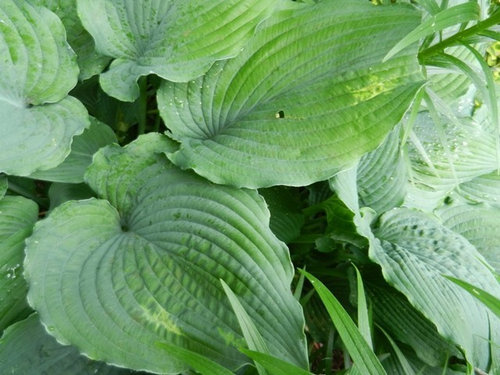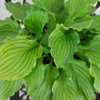this is not hvx.
in ny zone5
9 years ago
Recently I thought I had several hostas with HVX, but tests with Agdia strips showed that there was no HVX, probably bad winter caused it or some other virus. Last year I had 2 hostas with full-blown HVX in the same area, tested it with Agdia test strips to verfy it. Those were sudden cases, so this year I am on the lookout for several cases.
For symptom identification please click on 'Hosta Virus X' in the Hosta Library.
The tests with Agdia HVX ImmunoStrips showed only the control line, which indicates valid tests. The Test Line was not displayed, wich means NO HVX.
Last year I tested two h.'August Moon' for HVX. They had green ink bleed between two veins on several leaves. Result : no HVX. This year these plants have patches of green which could be 'collapsed tissue', but last weeks test again showed no HVX.
A 'St.Paul' showed blotches on several leaves, test shows no HVX. That might have been cold damage, plant corrected itself.
'Dancing Queen', last year it had 2 quarter size spots with green ink bleed, no test after test of August Moon. This year it has white ink bleed and blotches of white. Test result : no HVX.
Blue corrugated seedling, has several spots of white ink bleed. Test result : no HVX.
fortunei 'Albomarginata', blotches and white ink bleed. Test result : no HVX.
Please find below a picture of Two 'Queen of the Seas' growing side by side closely, white ink bleed. Test result : no HVX.
What could this be? Possibly another virus? When this gets worse, I should remove plants.
Bernd

This post was edited by berndnyz5 on Tue, Jun 10, 14 at 9:53




in ny zone5Original Author
in ny zone5Original Author
Related Discussions
HVX on Abiquia Drinking Gourd?
Q
Is there a soil treatment for HVX?
Q
Another HVX or not?
Q
A Couple HVX Questions
Q
in ny zone5Original Author
ken_adrian Adrian MI cold Z5
Jon 6a SE MA
trudy_gw
Jon 6a SE MA
in ny zone5Original Author
jamie81
trudy_gw
in ny zone5Original Author
in ny zone5Original Author
Jon 6a SE MA
in ny zone5Original Author